In the aftermath of Hurricane Sandy the issue of New York’s vulnerability to flooding has stepped to the forefront of media concerns. And rightly so. With a mountain of scientific data indicating the future holds increased threats from global warming, a coastal city like New York can ill afford to ignore the problem of flooding. But while the dramatic scenes of storm surges and the wreckage left in their wake are what stay in people’s minds, New York has long dealt with a less conspicuous flooding problem brought on by annual rainfall.
In the natural world soil plays a vital role in stormwater retention. One of the problems facing a city as heavily developed as New York is that it is almost completely paved over so there is no topsoil to provide stormwater retention and rainwater simply runs off the surface asphalt into the storm drains. When those drains are filled to capacity during heavy rains not only does the water pool in low lying areas, but it also floods the sewer system (to which the storm water system is connected in what is called a Combined Sewer Overflow system, or CSO) which then overflows into our rivers and streams.
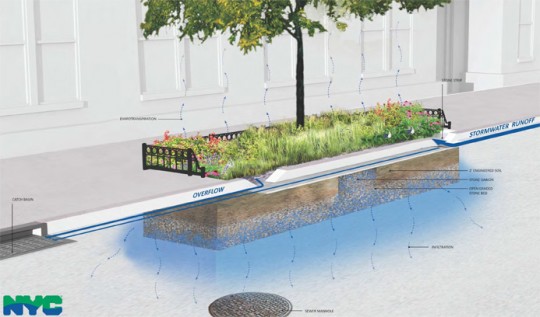
The city has been diligently working on an inconspicuous and cost-effective solution first proposed in the PlaNYC document of 2007 to use green infrastructure to combat this problem. As the name implies, green infrastructure utilizes the natural properties of plants and soil to retain water so that it doesn’t overtax the storm system. New York receives about 44 inches of rain a year, and as a consequence of changes in global weather patterns noted above, rather than being spaced out evenly, those 44 inches are starting to come in punctuated periods of more extreme weather. This is not only worse for the storm system but also for plants as temperate weather shifts to extremes of flood and drought, which is always harder on the environment. The Green Infrastructure initiative was created to figure out a way to retain at least 10% of this runoff in order to reduce flooding and pollution in specific areas of the city so as to meet federal water quality standards in problem areas like Jamaica Bay and the infamous Gowanus Canal, to name a few. And the way it accomplishes this is primarily through the use of bioswales and greenstreets.
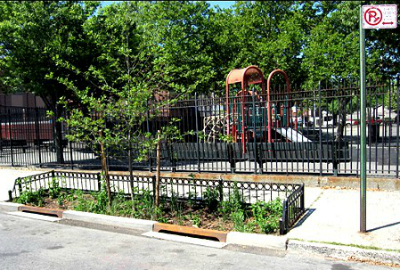
Think of a bioswale as a large planter buried in the street. It acts as a small cistern, strategically placed to follow the street grade to maximize its effectiveness, catching rainwater as it runs from an area of high elevation to low elevation. The soil in the bioswale soaks up the water like a sponge where it is captured, stored, and released in a controlled manner through infiltration into the surrounding soil, evaporation, and evapotranspiration (a combination of evaporation and being used by the vegetation).
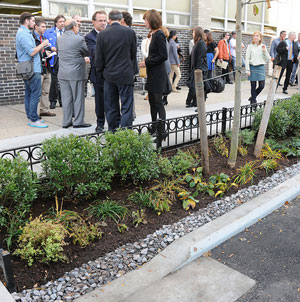
An important aspect of the bioswales is that they aren’t designed to be simply function as storm water retention. They are active microenvironments for the vegetation that gets planted there. Some of these plants are chosen mainly for their hardiness or resistance to pollution and flooding, but many are quite beautiful. Consequently the neighborhoods in which they are built will see an increase in property values and habitability due both the functional and aesthetic value of the bioswales. They provide benefits in other ways as well by adding shade from the trees as well as cooling the area in the summer heat through evapotranspiration. In addition, the green infrastructure initiative is actually working in conjunction with the Million Tree initiative, so wherever a bioswale is slated to be built it will include a tree.
During the planning stages a neighborhood will typically be sited for well over a hundred bioswales, but various zoning restrictions such as proximity to stop signs, parking meters, bus stops, fire hydrants, catch basins, existing trees, as well as surveying results and soil samples, and will typically winow this number down by about 60 to 75 percent. That’s still a lot of bioswales; enough to have a definitive impact on water retention as well as the beautification of the neighborhood. Each bioswale can capture about 250 cubic feet of water per rain event.
The other major green infrastructure program is greenstreets. Whereas bioswales are relatively small, about 20×5 ft (typically twice as big as current tree planters) greenstreets are considerably larger averaging about 2,000 square feet. (One greenstreet captured 25,000 gallons of water during hurricane Irene). Bioswales are also constructed on sidewalk space, whereas greenstreets are constructed in underutilized street space. Greenstreets serve the same purpose as bioswales, only on a larger scale and they are also equipped with scientific monitoring equipment to measure things like rainfall, temperature, evapotranspiration, windspeed, pollution, etc, all in an effort to continually improve the effectiveness of the design of green infrastructure through continual monitoring and feedback.
The Green Infrastructure Unit of the Parks Department also works with local people to get a better idea of what they want and how best to serve the neighborhood’s needs. For private property owners it’s possible to apply for a grant to install green infrastructure on your property, and the city also has an adopt a tree program where anyone can become a certified tree pruner taking care of your own swale. The hope is that by encouraging such civic participation the benefits of the program will reach a wider audience and it’s also been shown that trees that have been adopted live longer and are healthier.
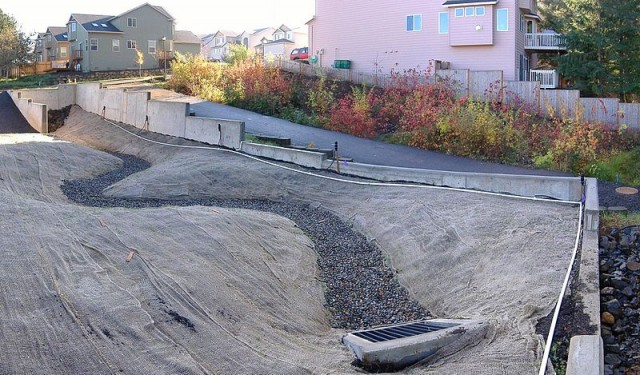
So where is this green infrastructure? Well there’s a chance you’ve seen the bioswales already but just didn’t notice them because on the surface they tend to look a lot like the street trees we’re all so used, only larger. And while they certainly beautify the neighborhood, they are designed to do so inconspicuously and unobstrusively. But don’t think these are just holes in the ground filled with dirt. From the stones that filter sediments to the soil bacteria that can actually break down hydrocarbon pollutants and render them inert, the external rustic simplicity of the design belies a complicated and highly engineered system of hydrological engineering, landscaping, and natural water filtration that has a definitive environmental impact while saving the city hundreds of millions of dollars in massive, unsightly, and noisy infrastructure projects. As the program develops, new solutions to unique problems are always being implemented and the green infrastructure itself is constantly evolving to become more efficient, more beautiful, and more cost-effective.
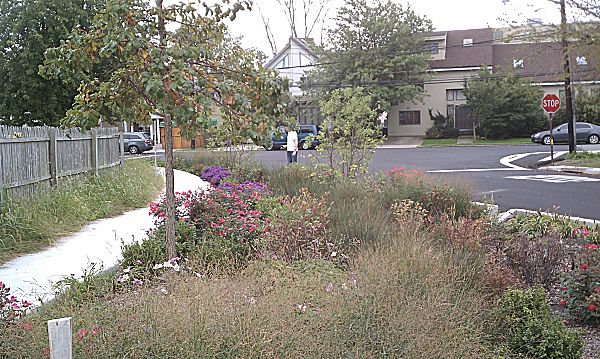
For a more in-depth look at this topic check out a lecture given by Nette Compton, Director of the Green Infrastructure Unit.
Photos: NYC Parks
1 Comment
Comments are closed.